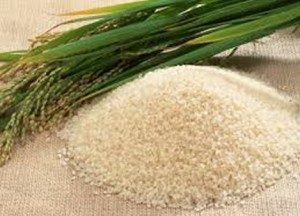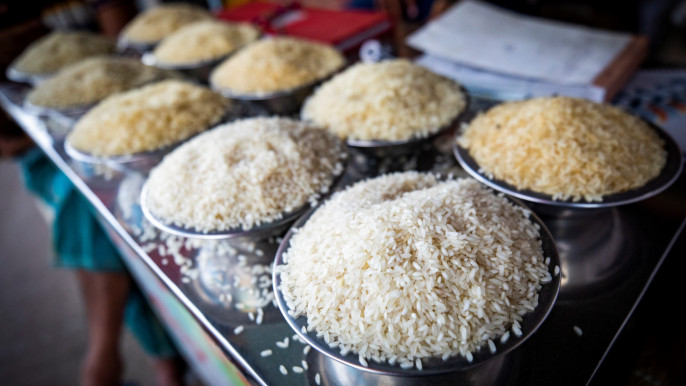Tags
Bali rice experiment cuts greenhouse gas emissions and increases yields
- Rice paddies are responsible for 11% of the world’s methane emissions. There are more than 200 million rice farms in Asia.
- Working with local farmers, researchers in Bali, Indonesia, have discovered how to dramatically reduce the greenhouse gas emissions output of rice fields. Initial indications are showing a 70% reduction.
- The farming breakthrough also boosted the yield of crops and reduced the amount of pesticides flowing to coral reefs.
“After we finished ploughing, we would bathe the cows and then relax in the field playing flutes,” said Jero Dodo, who has farmed the rice terraces of Tabanan, Bali, since he was 12 years old. While he speaks fondly of the past, the farmer has one foot in the future. Dodo, who spoke to Mongabay by phone, recently took part in a groundbreaking study that could not only put a dent in greenhouse gas emissions but also change the way rice farmers plant their fields.
Rice paddies are like mini power stations. Each stalk acts like a chimney and shoots greenhouse gas from the soil into the air. In particular, rice paddies are responsible for 11% of the world’s emissions of methane, one of the most dangerous greenhouse gases. More than 90 percent of the world’s rice is grown on some 200 million rice farms in Asia.
Results from a study by scientists I Wayan Alit Artha Wiguna of the Balai Pengkajian Teknologi Pertanian Bali and Steve Lansing of the Santa Fe Institute suggest changing irrigation methods could reduce the greenhouse gas (GHG) output of rice fields by 70%. Working in collaboration with farmers in Bali’s Tabanan regency, they found they could not only reduce GHG emissions but also use less water and boost crop yields.
Lansing, an ecological anthropologist, has studied Indonesia’s rice fields since he arrived in Bali in 1974 to work on his Ph.D. His focus was subak, a rice irrigation system managed by water temples, which had been in place since the 9th century until it was disrupted by the arrival of the Green Revolution in the 1960s and 1970s. Like their counterparts across the globe, Balinese farmers were encouraged to swap slow-growing local varieties for fast-growing hybrid rice, fertilizer and an extra harvest.

When Lansing arrived, the farmers were also discovering that these new methods resulted in water shortages and an explosion in pests. Over time, farmers spontaneously returned to their original methods and the harvests recovered. They switched to milder fertilizers but kept the hybrid rice.
While the Green Revolution may no longer dominate the conversation, rice paddies remain front and center due to their link to climate change and GHGs. This is what prompted the launch of a 3-year-long study that looked at tackling their emissions by regulating irrigation.
With the help of a farmer from Wiguna’s village, the scientists created a demonstration plot, which they studied from 2020-22. They filled one field with water, as is common in Bali, but they drained the other, wetting the soil only when hairline cracks were spotted in the earth — a signal decided upon by the farmer. Wiguna tracked emissions and water depth in the field.
“When the paddy is flooded, the soil turns anaerobic [free from oxygen],” said Wiguna in a phone interview. This creates ideal growing conditions for methane-emitting bacteria.
The researchers’ biggest concern was that while the new methods could reduce the release of methane gas, they might also trigger the release of nitrous oxide, which is a more potent GHG.
“We didn’t know what the dynamics of the nitrous oxide would be,” said Lansing. “We found it’s actually the repetitive process of cycles that triggers more nitrous oxide emission. There are only brief moments when nitrous oxide spikes, otherwise it is near zero most of the time.”

The results at the end of the first harvest were astounding, the researchers say. They found that in the drained field, the release of GHG had dropped by 70%, and the farmer who owned the demonstration plot saw his crop yield in the drained field rise by more than 20%. The researchers knew why the methane had been reduced, but initially they couldn’t work out why the crop was so bountiful. Then Lansing reflected on a study he’d carried out in 2005 on the impacts of fertilizer runoff on coral reefs. By draining the field, he concluded, the fertilizer remained in soil rather than being washed into the river system.
After three harvests, they decided to take their research to the next level and test their findings on different farms in the area. They approached Subak Bena, a community of 201 farmers.
“In the beginning, many of them opposed [the idea],” said Wiguna. “But I guaranteed that if their productivity decreased because of the intermittent system, [we] would pay for the tons that are lost.”
Eighteen local farmers decided to drain their plots, while 18 more served as control subjects by following their usual farming methods. Lansing had funded the initial research, but when they launched the pilot project, they sought funding from the Quantum Temple Impact Fund.
Quantum Temple, for which Lansing now serves as an adviser, agreed to cover the costs, should farmers experience a drop in yield. They also bought weeding machines for the farmers and covered the cost of the Israeli irrigation app Manna, which uses satellites to track the water levels and in turn methane output of the farmers’ individual fields in Bali.
The farmers started planting in February, and by July, they had replicated the experience of the demonstration plot. Even when the pilot was halfway through, the crops were looking so healthy that a further 10 farmers in the village who weren’t part of the project chose to drain their land. Lansing said the results of the study are about to be published in the journal Philosophical Transactions Royal Society B.
Dodo said he was nervous initially about draining the fields, so he chose to test it on 10 are (0.1 hectares or 0.25 acres). However, Dodo decided to follow the researchers’ strategy even when other farmers questioned his methods.
“I wanted to succeed so I could silence [the critics]. Now, those who used to [comment] have registered to try the system,” said Dodo.
Dodo’s fields would usually produce 2 tons of rice, but after trying the new system, he said he harvested 3.5 tons. The farmer would usually hire laborers to help him, but when he saw the results of the test, he wanted to do the harvest himself. “I was so proud,” he said.

Stephen Wood, a soil scientist for The Nature Conservancy who reviewed the team’s research said via email: “The big issue is the potential for nitrous oxide emissions to increase when you do this practice, which can cancel out the benefits from reducing methane. What this paper shows is potential to reduce both methane and nitrous oxide.”
What Wood found particularly interesting was the study’s focus on farmer-driven irrigation approaches. “There is still a lot of room for further studies, but this study presents an interesting new approach that builds on how farmers manage their own irrigation and looks at net emissions, not just methane.”
The aim is that the scheme will now have nationwide adoption. Since the pilot project’s results have been revealed, the number of farmers taking part has risen to 40 in Subak Bena, plus a group of four organic farms run by the Begawan foundation near Ubud, where the scientists will continue their research.
According to the researchers, all they need to do to scale up is to spread the word. The primary barrier to entry for farmers is a 500,000 rupiah ($33) weeding machine.
As Wiguna is the instructor for an agricultural research agency in Bali, he can share their discoveries. Lansing has also been invited to COP28 in the UAE in December to talk about their research.
Dodo is already planning his next harvest. “I will expand the system to 25 are [0.25 hectares or 0.62 acres], and then to 50 are. If I immediately jump to 50 are, then I’m afraid I’m not physically strong enough [for such a big crop] because I’m already old,” he joked.
https://news.mongabay.com/2023/08/bali-rice-experiment-cuts-greenhouse-gas-emissions-and-increases-yields/Published Date: August 15, 2023








